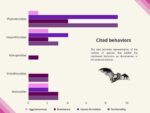Dominance relationships in Yangochiroptera: a review
Rhoxanne Luchesi, Lays C. ParolinYangochiroptera is a suborder recognized for having diversified food habits and unique social behavior. Based on a literature review, this study analyzed the inter-specific variation present in their social behavior, with an emphasis on dominance behavior. Harem formation, territoriality, and aggressiveness were shown to be connected to dominance behavior. The polygyny of defense of resources and defense of harem females appeared as mating systems in which the possibility of dominance appears to be greater. However, the small number of references dedicated specifically to this type of behavior makes it difficult to describe the patterns, and more studies focusing on the behavioral ecology of their species are needed.
Relações de dominância em Yangochiropteros: uma revisão. Yangochiroptera é subordem reconhecida por apresentar hábitos diversificados em relação à sua alimentação e também aos seus comportamentos sociais únicos. A partir de uma revisão bibliográfica, este estudo buscou analisar a variação interespecífica no comportamento social desse grupo — com ênfase em comportamentos de dominância. Formação de haréns, territorialidade e agressividade mostraram estar conectados ao comportamento de dominância. Já a poliginia de defesa de recursos e de defesa de fêmeas de harém, apareceram como sistemas de acasalamento nos quais a possibilidade da dominância aparenta ser maior. Contudo, o baixo número de referências voltadas especificamente para este tipo de comportamento dificulta a descrição de padrões, sendo necessários mais estudos focados na ecologia comportamental de suas espécies.
